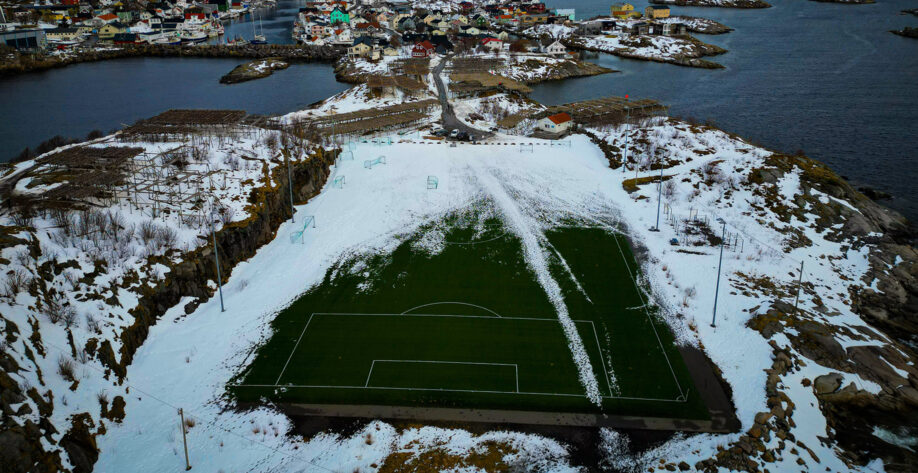With the incredible amount of snow we have received this year, especially in New England, it is important to have a plan in place to remove snow from your synthetic turf field in a careful and timely manner. Snow removal plans are crucial for avoiding delays to spring sports and costly repairs for damages related to improper removal. Below are some important factors to consider when creating a plan:
Logistics. Managing snow removal operations from a turf field requires a logistical procedure to protect the safety of the field, exterior equipment, and site amenities. Do you have a track or trench drain that circumscribes the field? If so, make sure the drain is clear of snow or ice to allow drainage when the snow melts. Also, prepare the turf curb for equipment to navigate over the lip. Use plywood or a manufacturer approved material to create a flush condition at the curb lip. This is especially important for maneuvering larger pieces of equipment
Whom to hire? If you don’t have trained operators or the proper equipment in house, ask your turf manufacturer for their recommendation. Manufacturers typically have a list of reputable contractors they recommend for the work. Be sure to hire a company with both field and plowing experience. While some contractors may have experience with synthetic turf fields, this does not mean they are experts in plowing snow. Claims occur every year from faulty plowing operations for areas on and off the fields.
Equipment and Vehicle Circulation. Use of Low Ground Pressure (LGP) tracks is highly recommended. Snow blowers are also an option if engineered for the job at hand. Bulldozers, dump trucks, and any large pieces of equipment should not be allowed on synthetic turf fields. Equipment that can exert a large concentrated load (over 300 pounds per square foot) on the field, and has the ability to turn sharply is a concern for the stability of the base. Repair of the base (the material located beneath the turf carpet) would most likely require removing the synthetic turf and infill material and re-grading that area. Be aware of the possibility of creating divots or depressions beneath your turf field. Vehicles should be inspected prior to each snow removal operation to make sure they aren’t leaking since leaks can cause permanent staining and/or breakdown of turf fibers. Vehicles should only be allowed to turn on a wide radius or when in forward motion, and should not be left idling or unattended since the exhaust could singe the turf fibers. Sudden braking and sharp turns can cause damage.
Buffer the blade. Many turf manufacturers describe proper methods used to plow fields within their maintenance manual. Attaching a PVC pipe to the bottom of the blade of a typical snow plow is often used. This allows a rounded edge so the blade doesn’t dig into the infill or make contact with the turf backing. It is highly recommended that the bottom edge of the blade is elevated by 1” – 2” above the top of the infill material to eliminate any chance of contact. If the blade is left untreated (no PVC pipe), or is allowed to make contact with the infill, there is a significant risk of transporting the infill to other parts of the field or even off-site with the disposal of the snow. When snow is wet, the underlying infill material and crumb rubber tends to cling to the snow above it. The bottom 1” of snow should be left to remain on the field during removal operations. Any remaining snow (approximately 1” deep) from plowing operations will melt off on the next sunny day.
Use a snow thrower or snow blower. Some companies have state-of-the-art equipment specifically designed for removing snow from synthetic turf surfaces. Snow throwers are becoming popular, especially for fields that have limitations due to perimeter fencing. Snow throwers can launch snow up to 70 feet. This may be of interest to owners who have a running track that circumscribes their field. Some snow blowers also have 1/2” high skis to make sure the blade stays elevated above the synthetic turf surface.
Load Limits. When initiating snow removal operations, make sure to consult your maintenance manual for information about load limits. Many turf manufacturers recommend a static or stationary load not to exceed 300 pounds per square foot. Manufacturers also recommend a rolling load limit of no more than 30 pounds per square inch, which accounts for ambulances or general maintenance vehicles that may visit the field. Unusual heavy loading can result in settling or rutting of the base material. This is especially true for snow stockpile areas. Permanent depressions can result from the heavy weight of snow. An 18” depth of snow over the footprint of the field can result in loads of approximately 31.5 pounds per square foot, or more. This amount of load is not a concern for the field, but when snow is stockpiled in an area and blended with ice or supplemented with rain, a pile of snow, water and ice mix could exert over 300 pounds of force per square foot!
Avoid Accumulation. Snow accumulation of more than a few inches becomes unmanageable for smaller pieces of equipment, such as pick-up mounted plows, that may be used for plowing operations on your synthetic turf field. Another problem is the formation of ice when snow begins to freeze/thaw. Any snow left standing on your field will freeze to an icy consistency as water is drawn out from the snow. If large storms are anticipated, your field should be plowed in 4’’ – 6’’ increments as needed.
Ice Removal and Chemical Treatment. Unlike powdery snow, ice causes many dilemmas for removal from synthetic turf surfaces since it prohibits the use of plows, snow blowers, and snow throwers. Though not all of the turf manufacturers’ maintenance manuals outline chemical treatment options, some recommend using calcium chloride for treatment of ice. Calcium chloride will leave a temporary residue on the turf’s surface and infill that will fade with time. Other manufacturers recommend spreading a pilled fertilizer grade urea at a rate of 100 pounds per every 3,000 square feet.
Cleaning up in the spring. After completing all of the plowing and snow blowing, there will need to be some touch-ups. Snow removal, regardless of how meticulous, usually leads to unbalanced areas of infill within your field. Sometimes unbalanced areas of infill require an industrial sized rotary brush or power brush to move the infill in large quantities over large distances. This would require more effort than typical field grooming operations. Many turf manufacturers or installers offer advanced care services that include final snow or ice clean up, as well as brushing and grooming the field in preparation for spring sports.
Plowing gone wrong. As an industry, we’ve learned from prior failures and developed standards and guidelines to prevent the likelihood of undesirable conditions. When infill material is removed from the field during snow removal operations, it is often left to maintenance staff to clean it up and remove it from the site. This results in a signifant depletion of infill from the turf playing surface resulting in compromising field performance and longevity. It is also very costly to replenish any lost infill as a result of poor plowing.
Remember, having a plan in place before the snow starts falling is the best way to avoid potential delays to spring sports and damage to your field. It you need assistance, contact Gale or consult your turf manufacturer.
Sources: Sprinturf, RAD Sports, APT, Shaw Sports Turf, FieldTurf, Turf Prep
Tagged In:
Athletic Facilities Planning & Design
